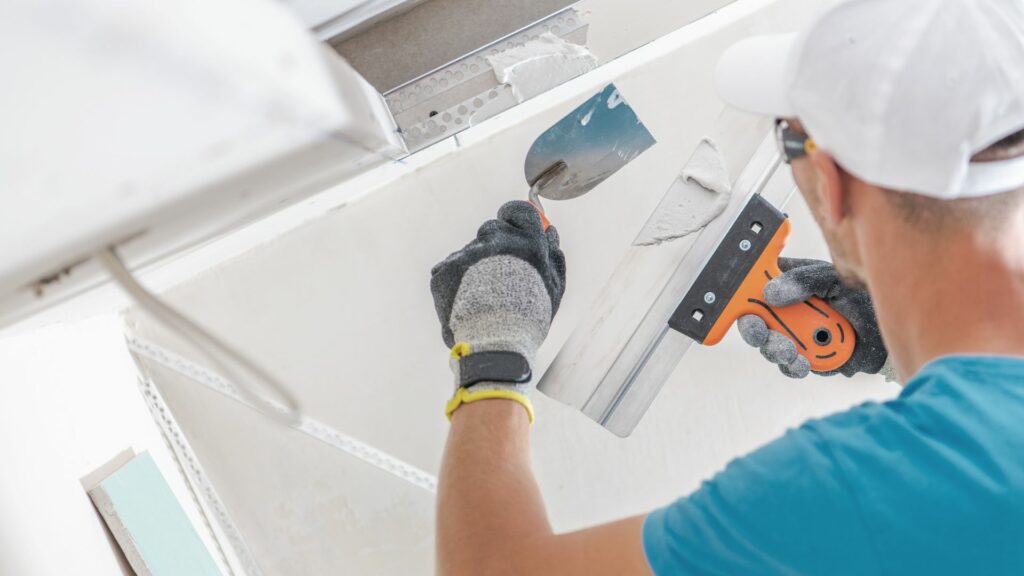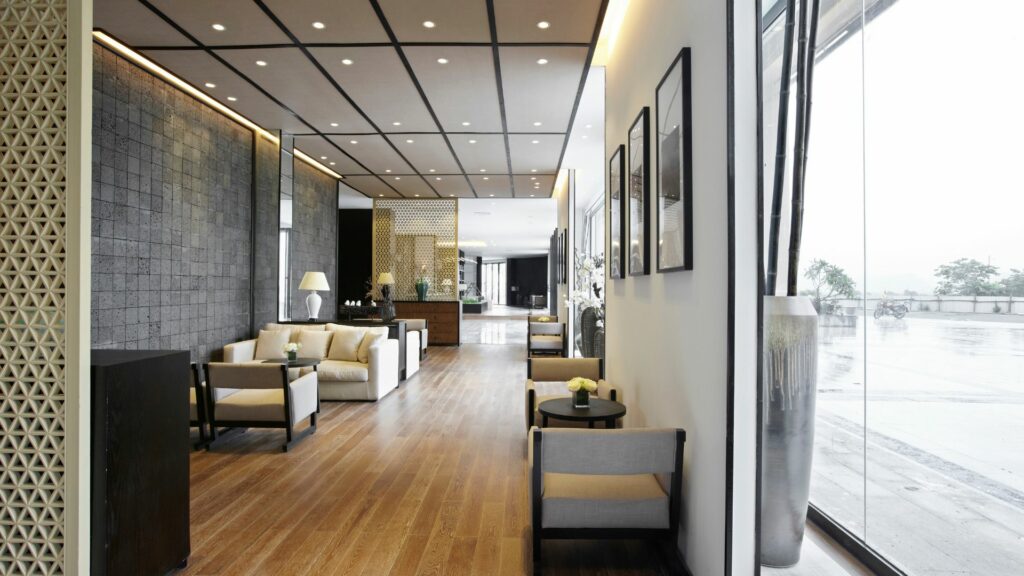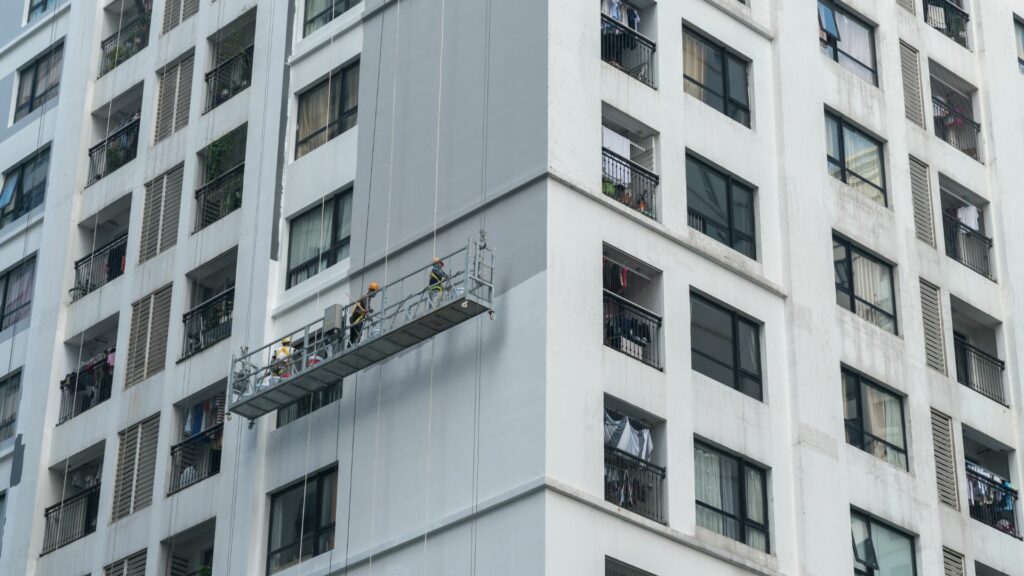Paint has the power to transform spaces, both inside and out. It can breathe new life into a room, create a welcoming atmosphere, and even increase the value of a property. When it comes to commercial painting, understanding the art of interior and exterior painting is crucial for property managers and facility managers looking to enhance their spaces.
In this blog post, we’ll explore the differences between interior and exterior paints, dive into the specifics of each type, and discover how the right paint can make all the difference in your commercial property.
Get ready to learn from the experts at W.T. Kenney Co. and elevate your space to new heights.
Key Takeaways
- Interior and exterior paints have distinct formulations. Exterior paints are made to withstand harsh weather, UV rays and temperature changes. Interior paints focus more on durability, washability and stain/moisture resistance.
- When choosing interior paint, consider the room’s function, traffic level, desired look, paint quality, finish, color, VOC content and professional advice.
- For exterior painting, thoroughly clean and repair surfaces, use primer, apply thin even coats with the right tools, and allow proper drying time. Consider your climate, surface material, paint durability, color, environmental impact and the painter’s reputation when selecting exterior paint.
Understanding the Differences Between Interior and Exterior Paints

Composition and properties
Interior and exterior paints differ in their composition and properties to suit their specific applications. Interior paints are formulated with resins, pigments, and additives that prioritize durability, washability, and low odor, while exterior paints contain ingredients that enhance resistance to fading, cracking, and moisture damage caused by harsh weather conditions.
Antimicrobial agents are often added to interior paints to prevent the growth of mold and mildew, ensuring a healthier indoor environment. Exterior paints may include UV-resistant chemicals to protect the surface from sun damage, as well as higher levels of volatile organic compounds (VOCs) to improve durability and weather resistance, although this can compromise air quality during application.
Application techniques
While the composition and properties of interior and exterior paints vary, the application techniques for these paints also differ significantly. Painters must consider factors such as surface preparation, priming, and the tools used for each type of paint.
For instance, exterior paints often require more extensive surface preparation due to exposure to the elements, while interior paints may need multiple coats for optimal coverage and durability.
Professional painters employ specific techniques to ensure a flawless finish, whether working on an interior or exterior project. They carefully select the appropriate brushes, rollers, or sprayers based on the paint type and surface being covered.
Skilled application methods, such as cutting in edges and corners or using the proper rolling technique, result in a smooth, even coat that enhances the overall appearance of the space.
Factors to consider when choosing
Choosing the right paint for your interior or exterior project is crucial for achieving the desired results. Consider these factors when selecting paint for your commercial property:
Environmental conditions: Take into account the exposure to sunlight, moisture, and temperature fluctuations that the exterior paint will face. For interior paint, consider the humidity levels and potential for mold or mildew growth in certain areas like bathrooms or kitchens.
Surface materials: Different surfaces require specific paint formulations for proper adhesion. Assess the materials you’ll be painting, such as wood, concrete, metal, or drywall, and choose a paint that is compatible with those surfaces.
Durability and resistance: Evaluate the level of wear and tear the painted surfaces will endure. High-traffic areas or exterior surfaces may require more durable paint with higher resistance to fading, chipping, or peeling.
Color and finish options: Consider the desired aesthetic for your space. Interior paints offer a wide range of colors and finishes, from matte to high-gloss, while exterior paints may have more limited options focused on durability.
Budget and timeline: Different types of paint and application methods can vary in cost and time required for completion. Assess your budget and timeline to determine the most suitable paint options for your project.
By carefully evaluating these factors, you can select the optimal paint for your commercial property’s specific needs. In the next section, we’ll delve into the intricacies of interior paints and how they can transform your space.
Everything You Need to Know About Interior Paints

Interior paints come in a variety of finishes, each with unique properties that affect durability, washability, and overall appearance. Choosing the right interior paint for your project depends on factors such as the room’s function, level of traffic, and desired aesthetic.
Properties, composition and characteristics
Interior paints possess unique properties, composition, and characteristics that set them apart from their exterior counterparts. The four main components of interior paints are pigments for color, binders for adhesion, solvents for consistency, and additives for various properties such as mildew resistance or quick drying.
These components work together to create a paint that adheres well to different surfaces, offers durability, and resists stains and moisture.
Interior paints come in various sheens or finishes, ranging from matte to high-gloss, each with its own benefits and drawbacks. The coverage ability and ease of application also vary depending on the type of paint, such as latex or oil-based.
Techniques and tips for application
After understanding the properties, composition, and characteristics of interior paints, it’s time to explore the techniques and tips for their application. Applying interior paints requires skill and knowledge to achieve a professional and long-lasting finish.
Here are some techniques and tips for applying interior paints:
Proper surface preparation: Clean the surface thoroughly, repair any cracks or holes, and sand the surface to create a smooth base for the paint to adhere to. Use a primer to seal the surface and improve paint adhesion.
Choose the right tools: Use high-quality brushes, rollers, or sprayers depending on the surface and the desired finish. Invest in good quality tools for better coverage and a smoother finish.
Use the right painting technique: For walls, use a roller for large areas and a brush for edges and corners. For trim and doors, use a brush or a small roller for a smooth finish. Apply the paint in thin, even coats for best results.
Maintain a wet edge: To avoid lap marks, always maintain a wet edge by overlapping each stroke slightly and working in small sections.
Allow adequate drying time: Follow the manufacturer’s instructions for drying time between coats. Allow the paint to dry completely before applying a second coat for best results.
Consider the room’s lighting: The lighting in a room can affect how the paint color appears. Test the paint color in different lighting conditions before making a final decision.
Ventilate the room: Ensure proper ventilation during and after painting to minimize the effects of paint fumes and to speed up the drying process.
Clean up properly: Clean your tools and equipment immediately after use to maintain their quality and prolong their life.
By following these techniques and tips, commercial property managers and facility managers can ensure a professional and long-lasting interior paint job that transforms their spaces and creates a welcoming environment for tenants and visitors alike.
Choosing the best interior paint
Choosing the right interior paint is essential for achieving the desired look and durability. Here are some key factors to consider when selecting interior paint for your commercial property:
- Quality: Opt for high-quality paints from reputable brands. These paints offer better coverage, durability, and resistance to fading, chipping, and peeling.
- Finish: Choose the appropriate finish based on the room’s function and desired appearance. Common finishes include flat, eggshell, satin, semi-gloss, and high-gloss. Flat finishes are ideal for low-traffic areas, while semi-gloss and high-gloss finishes are easier to clean and suitable for high-moisture areas like kitchens and bathrooms.
- Color: Select colors that complement the space’s purpose, lighting, and overall design. Neutral colors are versatile and timeless, while bold colors can create a striking impact. Consider the psychological effects of colors on mood and productivity when choosing paint for commercial spaces.
- VOC content: Look for paints with low volatile organic compound (VOC) content to minimize odors and potential health risks. Low-VOC or zero-VOC paints are environmentally friendly and safer for indoor air quality.
- Brand reputation: Research and choose paint brands known for their consistency, reliability, and customer support. Well-established brands often offer a wide range of colors, finishes, and specialized products for various applications.
- Professional advice: Consult with experienced painting professionals like W.T. Kenney Co. to get expert guidance on selecting the best interior paint for your specific project. With over 33,700 completed painting projects, they have the knowledge and expertise to recommend the most suitable products for your commercial property.
Everything You Need to Know About Exterior Paints

Exterior paints are specially formulated to withstand the elements, providing a durable and long-lasting finish that protects your property’s exterior surfaces.
Composition, properties, and characteristics
Exterior paints boast a unique composition that sets them apart from their interior counterparts. These paints contain higher percentages of resin, pigment, and binders, which contribute to their superior adhesion, flexibility, coverage, and color retention.
The inclusion of additives such as mildewcides and fungicides provides an extra layer of protection against the growth of mold, mildew, and algae, ensuring the longevity and integrity of the painted surfaces.
The thicker consistency and higher viscosity of exterior paints make them ideal for application on rough and porous surfaces, allowing for better coverage and a more even finish. Exterior paints are engineered to withstand harsh weather conditions and UV exposure, thanks to their durable and long-lasting formulations.
Tips and Techniques for application
Applying exterior paint requires careful preparation and technique to ensure a long-lasting, attractive finish. Here are some tips and techniques for achieving professional-looking results:
Thoroughly clean the surface: Remove dirt, grime, and loose paint using a pressure washer or scrub brush, and allow the surface to dry completely before painting.
Repair any damage: Fill cracks, holes, and other imperfections with a high-quality exterior spackling compound, and sand the area smooth once dry.
Prime the surface: Apply a coat of exterior primer to help the paint adhere better and last longer, especially on bare wood or metal surfaces.
Choose the right tools: Use high-quality brushes, rollers, or sprayers appropriate for the type of paint and surface you’re working with.
Check the weather: Paint on a dry day with low humidity and temperatures between 50-90°F (10-32°C) to ensure proper drying and adhesion.
Apply paint in thin, even coats: Multiple thin coats will provide better coverage and durability than one thick coat, and will help prevent drips and brush marks.
Allow adequate drying time: Follow the manufacturer’s recommendations for drying time between coats, and avoid painting in direct sunlight or hot conditions to prevent the paint from drying too quickly.
Pay attention to detail: Use a smaller brush or roller to paint trim, corners, and hard-to-reach areas, and maintain a wet edge to avoid lap marks.
By following these tips and techniques, you can achieve a professional-quality exterior paint job that will protect and beautify your commercial property for years to come. The impact of paint color on mood is another important factor to consider when transforming spaces inside and out with the art of painting.
Choosing the best exterior paint
When choosing paint for your property, it’s crucial to consider several factors to ensure optimal performance and durability. First, select a paint formula that can withstand the climate and weather conditions specific to your area—be it high humidity, extreme temperatures, or frequent rainfall. Additionally, the surface material plays a significant role in paint selection; different materials like wood, metal, or masonry each require specialized paints for the best adhesion and longevity. High-quality, durable paints are recommended to prevent issues such as fading, cracking, peeling, and chalking, even though they may have a higher initial cost, they prove more economical in the long run by reducing the frequency of necessary repaints.
Furthermore, choose colors that not only enhance the aesthetic appeal of your building but also contribute to energy efficiency; lighter shades are particularly beneficial in reflecting sunlight and maintaining cooler interior temperatures in warmer climates. Environmental impact is another critical consideration—opting for low-VOC or zero-VOC paints helps minimize harmful emissions and ensures a healthier environment for occupants. Always rely on reputable brands to guarantee consistent quality and performance. For the best results, professional application is key. Companies like W.T. Kenney Co. provide expert surface preparation and painting services, ensuring that each project is handled with the utmost care and expertise to achieve a flawless, durable finish.
Transforming Spaces Inside and Out with the Art of Painting
Transforming Spaces Inside and Out with the Art of Painting
Paint colors have a profound impact on the mood and atmosphere of any space, whether it’s a residential home or a commercial property. Professional painting services ensure that the job is done right, with the highest quality materials and techniques, to achieve the desired look and feel.
The impact of paint color on mood
Paint colors have a profound impact on the mood and ambiance of both interior and exterior spaces. Studies have shown that certain colors can evoke specific emotions and influence the overall atmosphere of a room or building.
For example, blues and greens are often associated with calmness and tranquility, while reds and oranges can stimulate energy and excitement.
Thoughtful selection of paint colors can transform a space, creating an environment that promotes productivity, relaxation, or inspiration. Commercial property managers and facility managers who understand the psychology of color can strategically use paint to enhance the desired mood and experience for their tenants and visitors.
Importance of professional painting services
Transitioning from the impact of paint color on mood, it’s crucial to recognize the importance of professional painting services. A skilled painting contractor brings expertise, experience, and the right tools to deliver high-quality results.
They understand the nuances of surface preparation, paint selection, and application techniques that ensure a flawless finish and long-lasting durability.
Engaging professional painting services saves time, reduces stress, and guarantees a superior outcome. Commercial property managers and facility managers can rely on the knowledge and craftsmanship of experienced painters to transform spaces efficiently and effectively.
Choosing the right paint for your project
Selecting the right paint for your property involves considering various factors that affect its performance and durability. Opt for a paint formula designed to endure your specific local climate and weather conditions, such as high humidity, extreme temperatures, or frequent rain. The type of surface material—whether wood, metal, or masonry—also dictates the choice of paint, as different materials require tailored solutions for optimal adhesion and longevity.
When choosing paint colors, consider both aesthetics and functionality. Lighter shades not only enhance the visual appeal of your building but also improve energy efficiency by reflecting sunlight and reducing interior heat in warmer climates. Additionally, prioritize environmentally friendly options by choosing paints with low or zero VOCs to ensure better air quality for occupants and minimal environmental impact. For professional results, enlist experienced painters like those at W.T. Kenney Co. to manage your painting project with expert care from surface preparation to final application, ensuring a beautiful and lasting finish.
Conclusion
In the world of interior and exterior painting, understanding the unique properties and techniques for each is essential. Interior paints are designed to enhance the ambiance and mood of indoor spaces, while exterior paints protect and transform the appearance of buildings.
W.T. Kenney Co., with its extensive experience and commitment to quality, has mastered the art of transforming spaces through painting. Their expertise in historical building restoration further showcases their dedication to preserving beauty and character.
By choosing the right paint and professional services, you can create a remarkable impact on any space, inside and out.
FAQs
1. What is the difference between interior and exterior painting?
Interior painting is done inside a building, while exterior painting is done on the outside of a building.
2. How do I choose the right paint for my interior or exterior project?
Consider factors such as the surface material, desired finish, and exposure to elements when selecting paint for your interior or exterior project.
3. How often should I repaint my interior or exterior surfaces?
The frequency of repainting depends on factors such as the quality of the previous paint job, exposure to wear and tear, and personal preference, but generally, interiors can be repainted every 5-7 years and exteriors every 7-10 years.
4. Can I paint my interior or exterior myself, or should I hire a professional?
While it is possible to paint your interior or exterior yourself, hiring a professional can ensure a high-quality, long-lasting finish and save you time and effort.
5. What are some popular color choices for interior and exterior painting?
Popular color choices for interiors include neutral tones like white, gray, and beige, while exteriors often feature colors that complement the style and architecture of the building, such as earth tones or bold accents.





